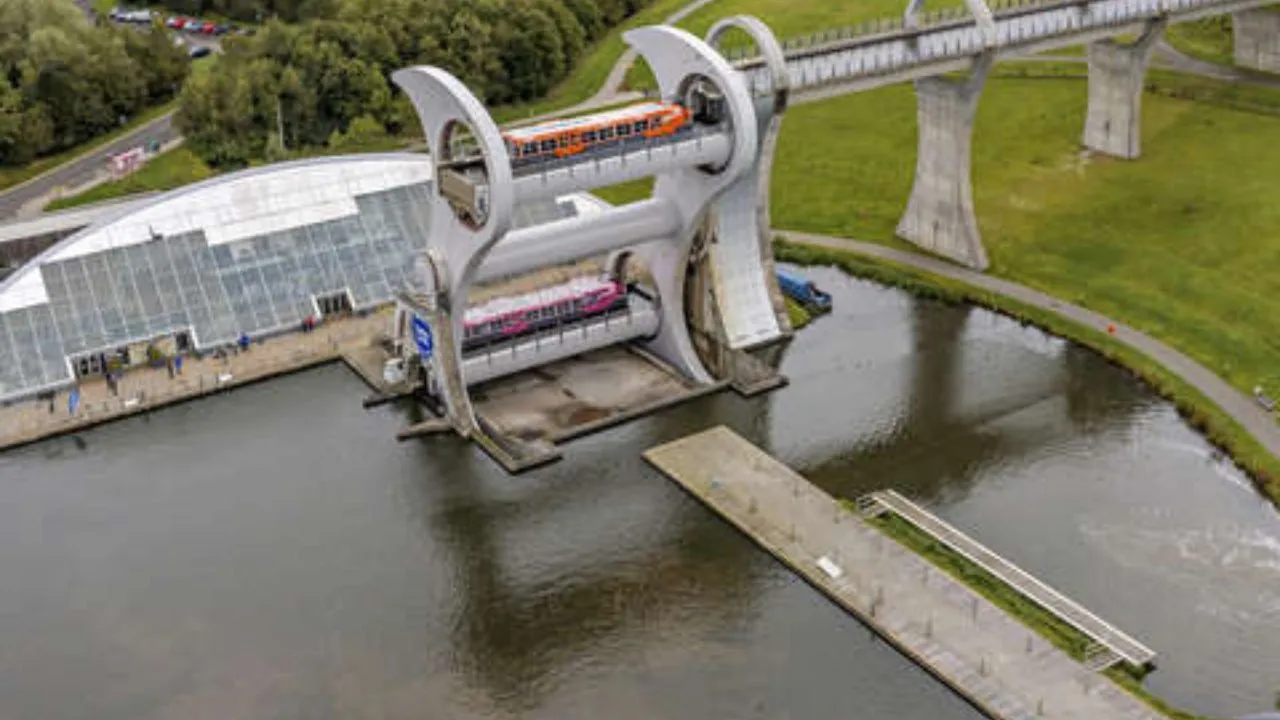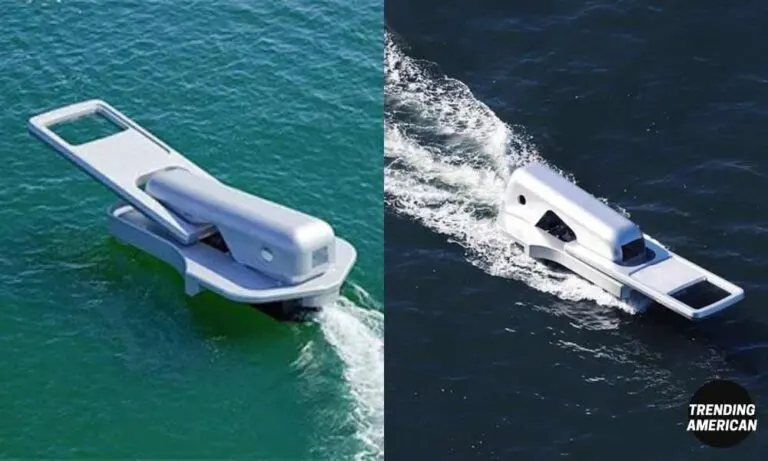The World’s First and Only Rotating Boat Lift | The Wheel Connects Two Canals and Raises Passing Boats By 79 ft!
A boat lift is a device people use to lift a boat out of water to keep it elevated. They use it for repairs, storage, etc. But rotating boat lifts are exceedingly rare. Of these Falkirk Wheel is the only rotating boat lift in the world. It connects the Forth and Clyde Canal with the Union Canal in Scotland and raises boats by 24 meters (79 feet). The boat lift first opened in 2002 as part of the Millennium Link project. The wheel reconnected the two canals for the first time since the 1930s. Let us find out more about this major tourist attraction and engineering marvel.
The History Behind the Falkirk Wheel
The idea for the Falkirk Wheel emerged in the late 20th century as part of the Millennium Link project. The Millennium Link aimed to rejuvenate Scotland’s canals and improve navigation between the east and west of the country. The original lock system connecting the Forth and Clyde Canal to the Union Canal had fallen into disrepair by the 1930s, making navigation impossible.
The authorities needed a solution to reconnect these waterways. So, engineers and architects collaborated to design a structure that would be functional and iconic. The design and construction of the Falkirk Wheel involved contributions from multiple engineering firms, including Butterley Engineering and RMJM Architects.
Engineering and Construction
Construction of the Falkirk Wheel began in 1999 and was completed in 2002. On May 24, 2002, Queen Elizabeth II officially opened the wheel. The total cost of the Millennium Link project was approximately £84 million, of which Falkirk Wheel accounted for around £17 million.

The Falkirk Wheel stands 115 feet tall and features a rotating design that can lift boats weighing up to 600 tonnes, including their cargo. The structure consists of over 1,200 tonnes of steel. Engineers assembled it using precision engineering techniques to ensure perfect balance and seamless operation.
The design of the wheel incorporates two arms shaped like a double-headed Celtic axe. These arms hold two water-filled caissons that can carry boats. The rotation process is powered by 10 hydraulic motors responsible for turning the wheel. Each full rotation of the wheel takes only five and a half minutes.
How the Rotating Boat Lift Works
The Falkirk Wheel operates using Archimedes’ principle, which states that a floating object displaces its weight in water. This principle ensures that the wheel remains perfectly balanced, regardless of the size or weight of the boats being lifted.

Image Source: Scottish Canals
The wheel consists of two gondolas, also known as caissons, each capable of holding up to 250,000 liters of water. When a boat enters a caisson, the weight of the boat displaces an equal weight of water, maintaining balance. This allows the wheel to use minimal energy to rotate. The energy required to lift a boat is equivalent to boiling about eight kettles of water. The structure uses just 1.5kWh for each rotation.
The hydraulic motors that power the wheel use a series of gears and cogs to rotate the structure. The largest cog, known as the sun gear, engages with smaller planetary gears. This system ensures smooth and controlled movement. The entire rotation process is monitored and managed by an automated control system. Site-wide computer control system maintain the water levels on each side. It maintains a difference of 37 mm (1.5 in) with water level sensors, automated sluices, and pumps.
Benefits of the Rotating Boat Lift
The Falkirk Wheel has become a major tourist attraction, drawing thousands of visitors each year. It has also significantly improved navigation between the Forth and Clyde Canal and the Union Canal. Before the wheel was constructed, a boat journey between the two canals required extensive detours and manual lock operation.

Image Source: Scottish Canals ( Leisure activities)
The rotating boat lift has contributed to the revitalization of the surrounding area. The site includes visitor facilities such as an exhibition center, gift shop, and café. Boat tours on the wheel offer visitors an opportunity to experience the lift’s operation firsthand. It is one of Scotland’s busiest tourist attractions, The Falkirk Wheel attracts around 500,000 visitors each year. The Wheel has transformed Falkirk into a key tourism destination. Visitors travel from all over the world to marvel at the working sculpture.
The visitors can engage in a range of activities. These include stand-up paddleboarding, self-driving electric boat rides, and canoe rides. Also, archery, a mini golf course, water zorbing, Segway tours, Magnet fishing, and bike rides.
Technical Challenges of the Rotating Boat Lift and Solutions
The design and construction of the Falkirk Wheel presented several technical challenges. One of the most significant was ensuring the precision of the rotation mechanism. Engineers needed to make sure that the wheel would rotate smoothly and consistently. To achieve this, the team used advanced computer modeling and simulation tools.
Another challenge was balancing the two caissons so that they would rotate efficiently without tilting. This required meticulous weight distribution analysis. The caissons are sealed with watertight gates to prevent water spillage during the rotation.
The durability of materials was also a key consideration. The steel used in the construction was specially treated to resist corrosion and withstand the elements. Regular maintenance is conducted to ensure that the structure continues to operate smoothly.
Environmental Impact of the Rotating Boat Lift
The Falkirk Wheel was designed with environmental sustainability in mind. The energy-efficient nature of the wheel allows it to use only a minimal amount of electricity. The construction of the wheel also included eco-friendly measures to reduce its environmental footprint.

Image Source: Scottish Canals
The wheel’s operation has minimal impact on local wildlife and surrounding habitats. The canals connected by the Falkirk Wheel support a variety of plant and animal species. Conservation measures are in place to protect these ecosystems.
Public Reception and Awards for the Rotating Boat Lift
Since its completion, the Falkirk Wheel has been recognized as an engineering and architectural achievement. It has won several awards, including the Saltire Society Civil Engineering Award. The wheel’s unique design has been praised for its combination of form and function.
It combines modern engineering and technology with ancient principles set out by Archimedes more than 2000 years ago. Visitors and engineers alike have lauded the Falkirk Wheel for its innovation and efficiency. The structure has become a symbol of modern Scottish engineering and a testament to the country’s ingenuity.
Future Prospects
The Falkirk Wheel continues to operate as both a functional part of Scotland’s canal system and a tourist attraction. Plans are in place to expand the visitor facilities to accommodate the increasing number of tourists. Educational programs and guided tours aim to inspire future generations of engineers and architects.
Conclusion
The Falkirk Wheel is more than just a rotating boat lift. It is a symbol of engineering excellence and innovation. Connecting the Forth and Clyde Canal to the Union Canal, the wheel stands as a testament to human ingenuity, providing a sustainable and effective solution for boat transportation while boosting tourism and preserving Scotland’s canal heritage.
Also Read:
The Only Country Located in All Four Hemispheres of The World | Rich History of Kiribati!
A Husband Spends Over 40 Years Growing a Guitar-Shaped Forest to Honor His Late Wife!







